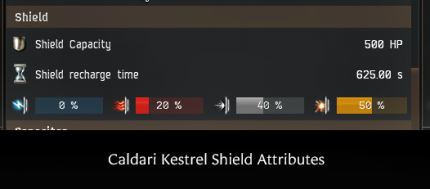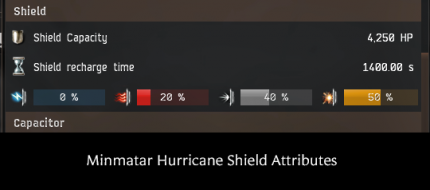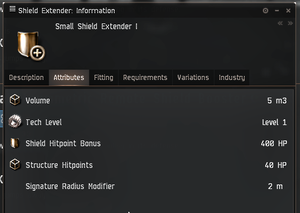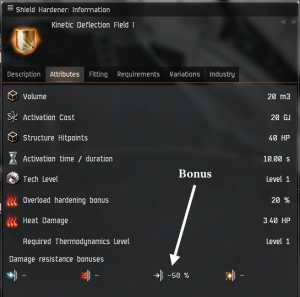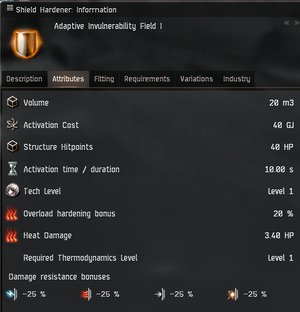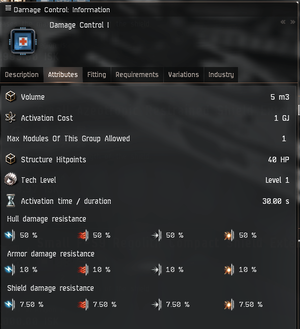More actions
category |
Removed confusing examples, combined the two stackign sections, combined the recharge rate sections. Overlaps with the other shield page |
||
| Line 1: | Line 1: | ||
{{Cleanup|Overlaps with [[Passive Shield Tank]].}} | |||
''This article explains the functional process of spaceship shielding. It does not cover the various tactical applications of shields. These can be found in such as:'' | ''This article explains the functional process of spaceship shielding. It does not cover the various tactical applications of shields. These can be found in such as:'' | ||
| Line 13: | Line 15: | ||
You can think of a shield as a sphere, completely enclosing the ship at a location just inside its [[Signature_radius|Signature Radius]]. [[File:QSG_shield_types.png|right|220px|alt=shield damage types (layers)]] Since the Signature Radius is the effective size of the ship – the area that is targeted by weapons – the shield intercepts any damage that occurs before it can reach the ship. At that point, the damage is filtered – some is rejected and the remainder is passed through to the ship's armor. | You can think of a shield as a sphere, completely enclosing the ship at a location just inside its [[Signature_radius|Signature Radius]]. [[File:QSG_shield_types.png|right|220px|alt=shield damage types (layers)]] Since the Signature Radius is the effective size of the ship – the area that is targeted by weapons – the shield intercepts any damage that occurs before it can reach the ship. At that point, the damage is filtered – some is rejected and the remainder is passed through to the ship's armor. | ||
The | The ships shields have a different shield resistance value for each of: [[Damage_types|thermal, kinetic, EM, and explosive]] damage. <span style="color:#ccffee">Resistance</span> indicates how much of that kind of damage will be rejected by the shield when the ship is hit by that kind of weapon. Resistance values are always shown in percentages – for example, "30% Thermal Resistance" means that the shield will reject 30% of the damage from any weapons hit that does thermal damage. | ||
[[File:QSG_shieldcapacity_dashboard.png|right|350px|alt=heads up display showing shield about half destroyed]]The shield also has a <span style="color:#ccffee">capacity</span> which shows how many hitpoints of damage it would take to destroy, or "drop", the shield. In combat this shows as the outermost of three red rings on the pilot's dashboard display. A ship's shield also has a <span style="color:#ccffee">recharge rate</span> which shows how fast the shield rebuilds itself while damaged. | [[File:QSG_shieldcapacity_dashboard.png|right|350px|alt=heads up display showing shield about half destroyed]]The shield also has a <span style="color:#ccffee">capacity</span> which shows how many hitpoints of damage it would take to destroy, or "drop", the shield. In combat this shows as the outermost of three red rings on the pilot's dashboard display. A ship's shield also has a <span style="color:#ccffee">recharge rate</span> which shows how fast the shield rebuilds itself while damaged. | ||
| Line 34: | Line 36: | ||
*Shield Resistance: EM:0% Thermal:20% Kinetic:40% Explosive:50%}} | *Shield Resistance: EM:0% Thermal:20% Kinetic:40% Explosive:50%}} | ||
Notice that both ships have the same four shield resistance values. This is because the resistances are expressed in percentages. The Hurricane starts out with almost three times as many hitpoints, thus each percentage absorbs considerably more damage than will the Kestrel. In each case the shield recharge time | Notice that both ships have the same four shield resistance values. This is because the resistances are expressed in percentages. The Hurricane starts out with almost three times as many hitpoints, thus each percentage absorbs considerably more damage than will the Kestrel. In each case the shield recharge time tells how long it takes for shields to go from empy to 99% capacity. The actual shield recharge rate varies quite a bit in combat – this is discussed in the [[#Shield Recharge Rate|Shield Recharge Rate]] section, below. | ||
===Resistance and Vulnerability=== | ===Resistance and Vulnerability=== | ||
[[File:QSG_hurricane_shield.png|400px|thumb|Base resistances of hurricane battlecruiser. The four resistances shown for this ship show how much of each type of damage the shield will reject.]] | |||
There are four types of damage, and a shield will deal with each separately based on shield resists. | |||
[[File:QSG_shielddefense.gif|260px|thumb|Animation showing damage rejection]] | |||
Each of these resistance values also represents a corresponding "vulnerability" number that shows how much damage will ''get through the shield'' for each hit of that kind of weapon. The Vulnerabilities are always 100% minus the resistances. So, for example, a ship with these resistances: | |||
Shield Resistance: EM:0% Thermal:20% Kinetic:40% Explosive:50% | Shield Resistance: EM:0% Thermal:20% Kinetic:40% Explosive:50% | ||
| Line 52: | Line 56: | ||
This is the damage that would impact on the shield if the ship flew with no benefits from skills, modules or rigs. ''Because of the way the shield damage reduction modules and rigs work, it is often more useful to focus on the shield's Vulnerabilities than its Resistances.''{{clear}} | This is the damage that would impact on the shield if the ship flew with no benefits from skills, modules or rigs. ''Because of the way the shield damage reduction modules and rigs work, it is often more useful to focus on the shield's Vulnerabilities than its Resistances.''{{clear}} | ||
===Shield Capacity=== | ===Shield Capacity=== | ||
| Line 94: | Line 80: | ||
*Capacitor Use: no | *Capacitor Use: no | ||
*Applies to damage type(s): all | *Applies to damage type(s): all | ||
}} | }} | ||
| Line 260: | Line 219: | ||
{{sk | Capital Shield Emission Systems }} – 5% reduced capacitor need for capital shield emission system modules per skill level | {{sk | Capital Shield Emission Systems }} – 5% reduced capacitor need for capital shield emission system modules per skill level | ||
== | ==Shield Recharge Rate== | ||
[[File:Shield_recharge.png|400px|thumb|Measured shield HP during passive recharge from zero and theoretical shield HP from formula plotted. Click to enlarge.]] | [[File:Shield_recharge.png|400px|thumb|Measured shield HP during passive recharge from zero and theoretical shield HP from formula plotted. Click to enlarge.]] | ||
[[File:Shield recharge rate.png|400px|thumb|Shield recharge rate as function of shield HP according to the formula. Click to enlarge.]] | |||
It takes a certain amount of time to recharge a fully depleted shield. This figure is given as the Shield Recharge Time in the ship's Attribute window. Recharging, however, does not tick along like the numbers on a clock. The speed varies depending on how full the shields are. | |||
As the shield takes damage, and it's capacity goes '''''down''''', the rate at which it rebuilds itself goes '''''up'''''. The increase in shield recharge rate continues until it peaks at 25% shield capacity. At this point a buzzer will sound, to warn the pilot that the shield is at its recharging limit. If it continues to take more damage than it can hold, the recharge rate will drop off quickly, and the capacity of the shield will fall towards zero. | |||
{{ note box | THE MAIN POINT: In combat the shield will recharge at an increasing rate until 25% of its capacity remains; then the rate will fall off quickly towards zero.}} | |||
The shield recharge rate depends on shield maximum capacity and shield recharge time. | |||
Shield recharge rate follows same formula as [[capacitor recharge rate]]. | Shield recharge rate follows same formula as [[capacitor recharge rate]]. | ||
| Line 284: | Line 250: | ||
The peak recharge Rate is 250% of average shield recharge. It occurs when the capacity of the shield is at 25% of its maximum value. Shield recharge rate drops rapidly below 25% shield capacity. | The peak recharge Rate is 250% of average shield recharge. It occurs when the capacity of the shield is at 25% of its maximum value. Shield recharge rate drops rapidly below 25% shield capacity. | ||
== | == Fitting Multiple Modules with Stacking Penalties == | ||
Shield resistance modules are subject to [[Stacking_penalties|Stacking penalties]] which progressively reduce the effectiveness of the modules if they alter the same attribute. In other words, the second module is less than 100% effective, the third even less so, and so on. | |||
The penalty only applies to the module's impact on the affected attribute, and progresses as follows: | |||
:1st mod: 100.0% effectiveness | |||
:2nd mod: 86.9% effectiveness | |||
:3rd mod: 57.1% effectiveness | |||
:4th mod: 28.3% effectiveness | |||
:... etc. | |||
The modules are penalized in order from least effective to more effective - the "best" module for that attribute will be the one that works at 100%; the "second best" one at 86.9%. It is not recommended to fit more than two or three resist modules that are stacking penalized. | |||
In addition to stacking penalties the shield resists aren't added together directly. Two 30% unpenalized resist modules will not give your ship 60% resist profile. You can think that each resist module reduces incoming damage individually. With incoming hit of 100 damage the first 30% resist module would reduce the hit to 70 damage and the second resist module would further reduce 70 damage to 49 damage giving total resist of 51% instead of 60%. | |||
[[Category:Ship Fitting]] | [[Category:Ship Fitting]] | ||
[[Category:Tank]] | [[Category:Tank]] | ||
[[Category:Game mechanics]] | [[Category:Game mechanics]] | ||
Revision as of 14:07, 16 March 2017
This article explains the functional process of spaceship shielding. It does not cover the various tactical applications of shields. These can be found in such as:
Nor does it cover the detailed fitting of shields to specific ships. This can be found in such as:
The descriptions of the various ships include shield fits as appropriate to the hull. (See Hurricane, for example.)
What Is a Shield?
You can think of a shield as a sphere, completely enclosing the ship at a location just inside its Signature Radius.
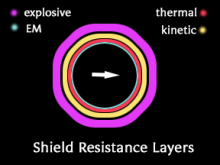
Since the Signature Radius is the effective size of the ship – the area that is targeted by weapons – the shield intercepts any damage that occurs before it can reach the ship. At that point, the damage is filtered – some is rejected and the remainder is passed through to the ship's armor.
The ships shields have a different shield resistance value for each of: thermal, kinetic, EM, and explosive damage. Resistance indicates how much of that kind of damage will be rejected by the shield when the ship is hit by that kind of weapon. Resistance values are always shown in percentages – for example, "30% Thermal Resistance" means that the shield will reject 30% of the damage from any weapons hit that does thermal damage.
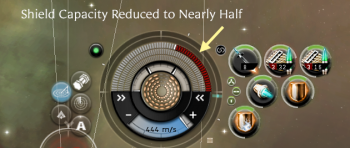
The shield also has a capacity which shows how many hitpoints of damage it would take to destroy, or "drop", the shield. In combat this shows as the outermost of three red rings on the pilot's dashboard display. A ship's shield also has a recharge rate which shows how fast the shield rebuilds itself while damaged.
The base values for all of these can be found in the Attributes panel of the ship's Show Info window.
Notice that both ships have the same four shield resistance values. This is because the resistances are expressed in percentages. The Hurricane starts out with almost three times as many hitpoints, thus each percentage absorbs considerably more damage than will the Kestrel. In each case the shield recharge time tells how long it takes for shields to go from empy to 99% capacity. The actual shield recharge rate varies quite a bit in combat – this is discussed in the Shield Recharge Rate section, below.
Resistance and Vulnerability
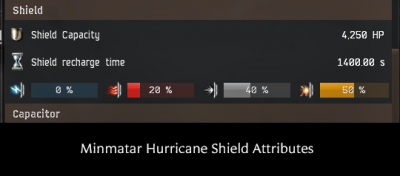
There are four types of damage, and a shield will deal with each separately based on shield resists.
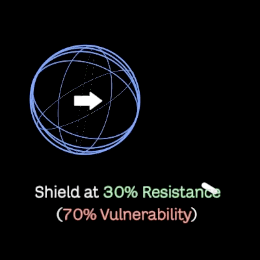
Each of these resistance values also represents a corresponding "vulnerability" number that shows how much damage will get through the shield for each hit of that kind of weapon. The Vulnerabilities are always 100% minus the resistances. So, for example, a ship with these resistances:
Shield Resistance: EM:0% Thermal:20% Kinetic:40% Explosive:50%
would have these vulnerabilities:
Shield Vulnerability: EM:100% Thermal:80% Kinetic:60% Explosive:50%
This is the damage that would impact on the shield if the ship flew with no benefits from skills, modules or rigs. Because of the way the shield damage reduction modules and rigs work, it is often more useful to focus on the shield's Vulnerabilities than its Resistances.
Shield Capacity
Shield capacity indicates how many hitpoints of damage it will take to drop the shields. (The ship itself is also protected by Armor and Hull defenses, and so it will take considerably more than than that to destroy the entire ship.) In general, the larger the ship, the larger the base shield capacity.
You can think of a shield's capacity as its current size; whenever the shield takes damage of any kind, its capacity goes down, and it shrinks. So while hits that do thermal, kinetic, EM, and/or explosive damage may be mitigated by the shield's resistance layers, any damage that does get through will be subtracted from the Shield Capacity value. This reduction will appear on the pilot's dashboard as a red mark in the outer shield ring.
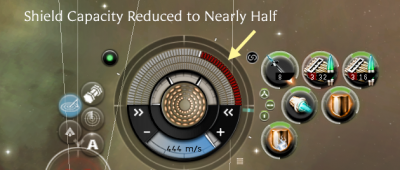
Shield Booster and Extender modules add hitpoints to the capacity of the shield and increase the total amount of damage that the shield can take before it is destroyed. Because the total shield recharge time never changes, increasing the shield capacity will also reduce the shield recharge rate. Core Defense Field Extender rigs also extend shield capacity, but at the expense of Signature Radius.
Damage Type Resistance
As noted in the Resistance and Vulnerability section, above, weapon strikes result in one or more of four types of damage: thermal, kinetic, EM, and/or explosive. Various modules mitigate specific types of damage. These modules often have stacking penalties. and while dealing with those is a matter of ship fitting, and not are discussed in detail here, an illustrative example is included, below.
Shield Hardener and Resistance Amplifier modules reduce the Damage Type Vulnerabilities of the shield. Anti-Damage Type Screen Reinforcer rigs reduce specific Damage Type Vulnerabilites, but increase the ship's Signature Radius.
Since you need a different module for each type of damage, and since most ships do not have enough medium level power slots to handle more than a few modules, it is difficult to use these kinds of modules to protect against all types of damage. One solution is to load the kind of module you need for the expected encounter. Another is to use a "multi-type" module that protects against all damage types.
The following module is listed under Armor and Hull in the EVE Ship Equipment list. It has unique properties and is widely used in many different fits.
Using Shields
In some cases the technical construction of the ship dictates the use of Shields (or Armor) as its primary defense. Any ship receiving a bonus to shield capabilites would likely use shields. And because most shield modules use medium level power slots, a ship with more mid than low slots will tend to use shields.
For example, these ships will usually use shields:
- The ORE Procurer, a mining ship, receives a 5% bonus to shield hitpoints.
- The Caldari Moa, a cruiser, receives a 4% bonus to all shield resistances.
- The Caldari Kestrel, a frigate, has four mid slots and only two low slots.
On the other hand, these ships will usually use armor:
- The Amarr Prophecy, a battlecruiser, has seven low slots and four medium slots.
- The Gallente Incursus, a frigate, has a 7.5% bonus to Armor Repairer amount.
It is worth noting that many ships can use either shields or armor. In these cases the choice is a matter of fitting ... what is the goal of the fit, and what are the skills of the pilot?
Advantages of Shields
- Does not reduce speed or maneuverability
- As a first line of defense, leaves you with Armor and Hull as a fallback if shields go down
- Recharge on their own – no need to dock for repairs
- Shield recharge modules work more quickly than armor repair modules
- Low slots are available for weapon enhancing modules
Disadvantages of Shields
- Increases signature radius – ship becomes easier to target
- Fewer kinds of enhancement modules – less choice than with armor
- Shield recharge modules use more capacitor power than armor repair modules
- Mid slots are not available for EWAR, propulsion and scanning modules
Shield Tanking
The term "shield tanking" refers to the use of shields as a ship's primary defensive mechanism. There are three general approaches to Shield Tanking:
- Active – use modules that draw on the ship's capacitor to improve shield performance
- Passive – use modules that do not draw on the ship's capacitor; mostly to improve shield recharge rate
- Buffer – use modules that do not draw on the ship's capacitor; mostly to increase the shield's capacity and resistance
This topic is covered in depth in the course on Shield Tanking, and in the article on Passive Shield Tank.
Logistical Shielding
Logistical shielding is the use of one ship's modules to apply shield protection to a different ship. This is covered in the E-UNI courses Logistics 101: Introduction to Logistics and the document Guide to Logistics.
Ships that Use Shields
Every ship has a shield. Whether or not a pilot decides to expand and improve the shield is his or her choice. You can find lists of ships that are commonly tanked with shields, but unless you are in a drastic hurry, you are better off choosing a ship that fits your situation and THEN deciding whether to use shields or armor as your primary defense.
That said, here are the factors that you look for when you are thinking about shields:
- a ship bonus that favors shields over armor,
- a shortage of low or a surplus of mid power slots,
- more need to favor modules that improve weaponry (which tend to need low slots),
- less need for modules that support tackling and scanning (which tend to need mid slots),
- pilot skills that are biased towards shields.
Shield Skills
A variety of skills improve a pilot's use of shields. Some of these are important to all pilots, while others are most important to pilot's who "shield tank" their ships and depend on shields as the primary means of defense.
Basic Shield Skills
These will be useful to any pilot and should be trained as soon as possible at least to Level III.
Shield Management – 5% bonus to shield capacity per skill level
Shield Operation – 5% reduction in shield recharge time per skill level
Shield Upgrades – 5% reduction in shield upgrade powergrid needs
Tactical Shield Manipulation – Reduces the "bleed through" of damage when the shield falls below 25% by 5% per skill level
Shield Tanking Skills
These are of most use to pilots who depend on shields as their primary defense. Refer to the article on Shield Tanking for detailed information.
Shield Compensation – 2% less capacitor need for shield boosters per skill level
Thermal Shield Compensation, Kinetic Shield Compensation, Explosive Shield Compensation, EM Shield Compensation – 5% bonus to damage resistance per level for Shield Amplifiers of the type listed
Other Shield Skills
These require advanced training and are of little use to newer players.
Shield Emission Systems – providing shield capacity to other players ... used in Logistics.
Capital Shield Operation – 2% reduction in capacitor need for capital shield boosters per skill level
Capital Shield Emission Systems – 5% reduced capacitor need for capital shield emission system modules per skill level
Shield Recharge Rate
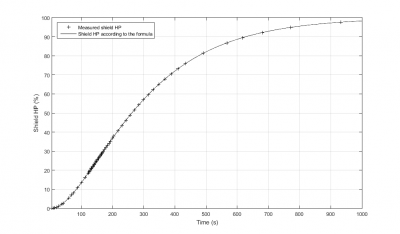
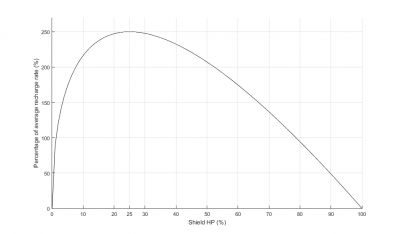
It takes a certain amount of time to recharge a fully depleted shield. This figure is given as the Shield Recharge Time in the ship's Attribute window. Recharging, however, does not tick along like the numbers on a clock. The speed varies depending on how full the shields are.
As the shield takes damage, and it's capacity goes down, the rate at which it rebuilds itself goes up. The increase in shield recharge rate continues until it peaks at 25% shield capacity. At this point a buzzer will sound, to warn the pilot that the shield is at its recharging limit. If it continues to take more damage than it can hold, the recharge rate will drop off quickly, and the capacity of the shield will fall towards zero.
The shield recharge rate depends on shield maximum capacity and shield recharge time.
Shield recharge rate follows same formula as capacitor recharge rate.

...where:
C is your current shield HP.
Cmax is your maximum shield HP.
dC/dt is your current shield recharge rate in HP/s.
τ is shield recharge time divided by 5.
The average shield recharge rate can be computed by dividing the shield capacity by its recharge time.
Average HP/s = Shield maximum / Recharge time
Recharge time does not depend on shield capacity. This means that if two ships have the same RT and one has more shield capacity, then the one with the larger capacity will recharge faster.
The peak recharge Rate is 250% of average shield recharge. It occurs when the capacity of the shield is at 25% of its maximum value. Shield recharge rate drops rapidly below 25% shield capacity.
Fitting Multiple Modules with Stacking Penalties
Shield resistance modules are subject to Stacking penalties which progressively reduce the effectiveness of the modules if they alter the same attribute. In other words, the second module is less than 100% effective, the third even less so, and so on.
The penalty only applies to the module's impact on the affected attribute, and progresses as follows:
- 1st mod: 100.0% effectiveness
- 2nd mod: 86.9% effectiveness
- 3rd mod: 57.1% effectiveness
- 4th mod: 28.3% effectiveness
- ... etc.
The modules are penalized in order from least effective to more effective - the "best" module for that attribute will be the one that works at 100%; the "second best" one at 86.9%. It is not recommended to fit more than two or three resist modules that are stacking penalized.
In addition to stacking penalties the shield resists aren't added together directly. Two 30% unpenalized resist modules will not give your ship 60% resist profile. You can think that each resist module reduces incoming damage individually. With incoming hit of 100 damage the first 30% resist module would reduce the hit to 70 damage and the second resist module would further reduce 70 damage to 49 damage giving total resist of 51% instead of 60%.

